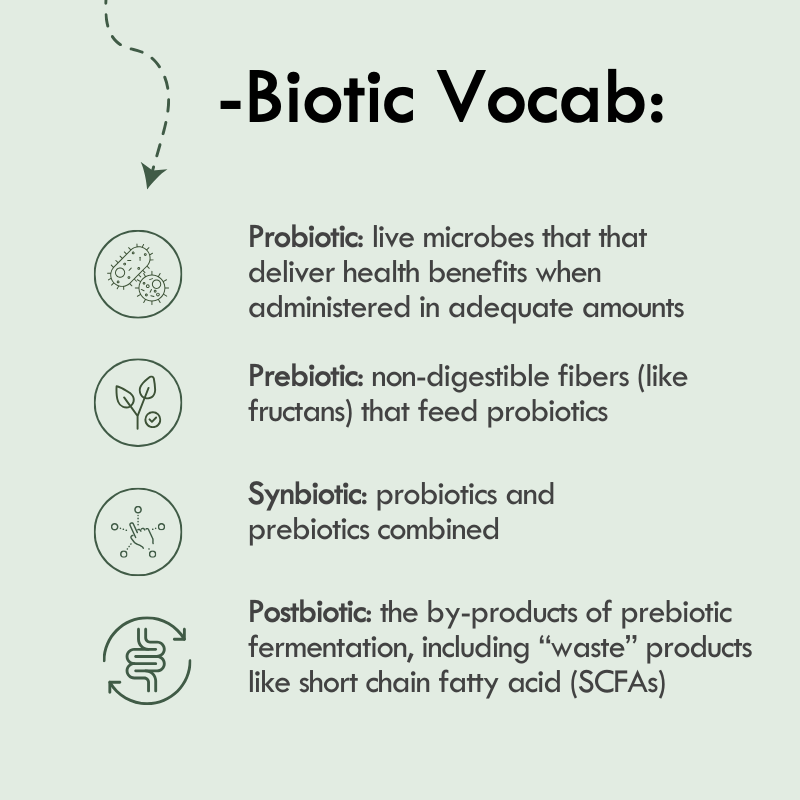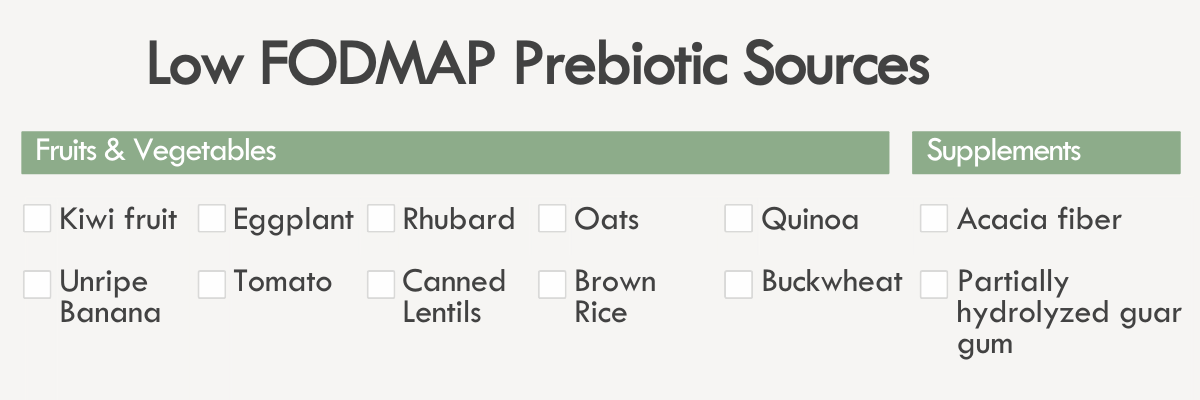What to know about postbiotics and FODMAPs
The science of -biotics and their benefits

The science of -biotics and their benefits
Prebiotics, probiotics, postbiotics, synbiotics... Oh my!
The Alphabet Soup of -biotics can confuse patients so it’s helpful to educate on the basic definitions before getting into the benefits of each:

Probiotics “feed” on prebiotics by fermenting them, which is why fructans and other prebiotics can also cause gas and bloating.
Postbiotics (aka SCFAs) support gut health. SCFAs reduce the osmotic load of malabsorbed sugars, support a healthy intestinal barrier by feeding colonic cells, and help regulate the immune system and inflammatory responses [1].
Prebiotic-rich Foods
Unfortunately, many prebiotic sources are also high FODMAP, such as onion, garlic, asparagus, artichoke, legumes and wheat.

Long-term reduction of FODMAPs and their prebiotic benefits can have a negative impact on the microbiome [2]. While postbiotic supplements (eg. butyrate) are available, more research is needed on the benefits of SCFA supplementation versus consumption of prebiotic-rich foods [3].
We all know how important it is to reintroduce as many foods as possible while on a low FODMAP diet. But what's the best approach to add high FODMAP foods, while controlling symptoms?
Diet Liberalization with Digestive Enzymes
Digestive enzymes are a tool to support reintroduction of prebiotic-rich foods while still limiting overall FODMAP load. Use a symptom tracker with patients to pinpoint trigger foods and portions, then help them integrate FODMAP triggers back into their diet using digestive enzymes.
For patients with food fears, digestive enzymes can be a particularly useful way to help them develop a more positive relationship with food.

Our peer-reviewed research on FODZYME supports the use of digestive enzymes for gut health. In a simulated gut model, SCFA production was reduced but not depleted, which means that FODZYME’s enzymatic approach may be more favorable to overall colonic health than avoiding FODMAPs altogether [4].
This means patients can get the best of both worlds: symptom control + benefits of prebiotic fiber and SCFAs.
Learn More & Get Started
Hear from RDs around about how FODZYME is helping their patients.
References
[1] Alexander C, Swanson KS, Fahey GC, Garleb KA. Perspective: Physiologic Importance of Short-Chain Fatty Acids from Nondigestible Carbohydrate Fermentation. Adv Nutr. 2019;10(4):576-589. doi:10.1093/advances/nmz004
[2] Valdes AM, Walter J, Segal E, Spector TD. Role of the gut microbiota in nutrition and health. BMJ. 2018;361:k2179. Published 2018 Jun 13. doi:10.1136/bmj.k2179
[3] Żółkiewicz J, Marzec A, Ruszczyński M, Feleszko W. Postbiotics-A Step Beyond Pre- and Probiotics. Nutrients. 2020;12(8):2189. Published 2020 Jul 23. doi:10.3390/nu12082189
[4] Ochoa KC, Samant S, Liu A, et al. In Vitro Efficacy of Targeted Fermentable Oligosaccharides, Disaccharides, Monosaccharides, and Polyols Enzymatic Digestion in a High-Fidelity Simulated Gastrointestinal Environment. Gastro Hep Advances. 2023;2(3):283-290. doi:https://doi.org/10.1016/j.gastha.2022.10.011

